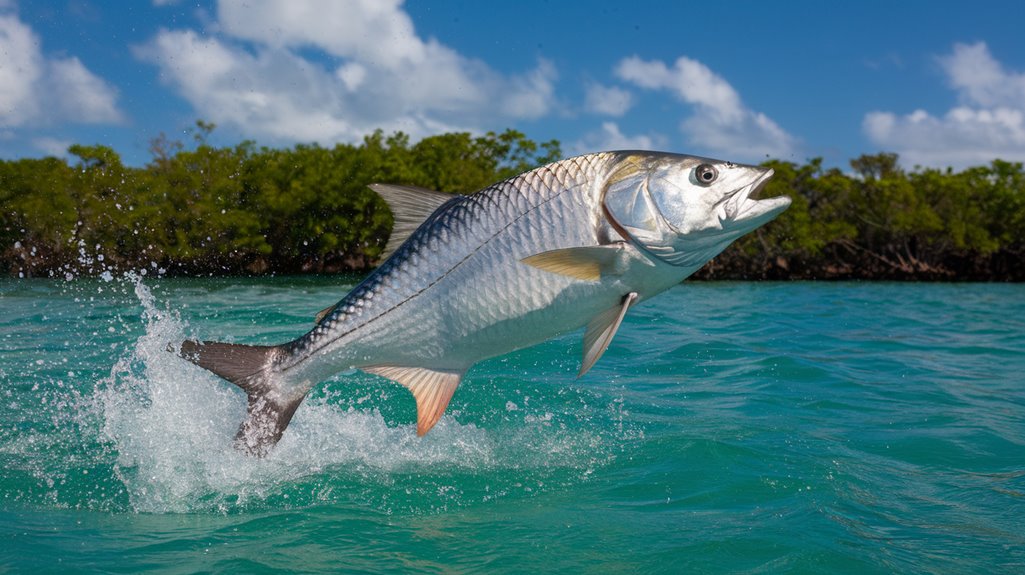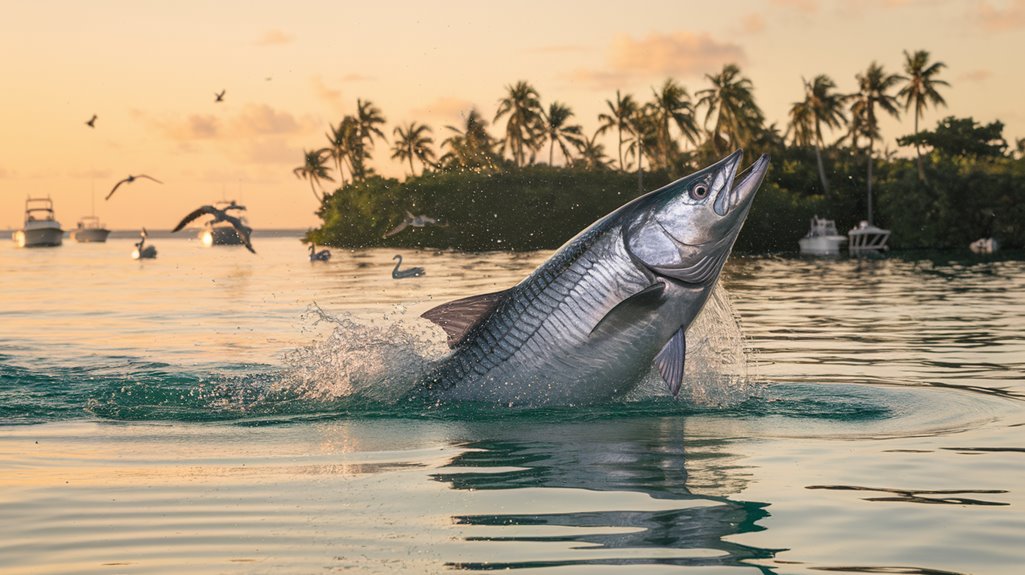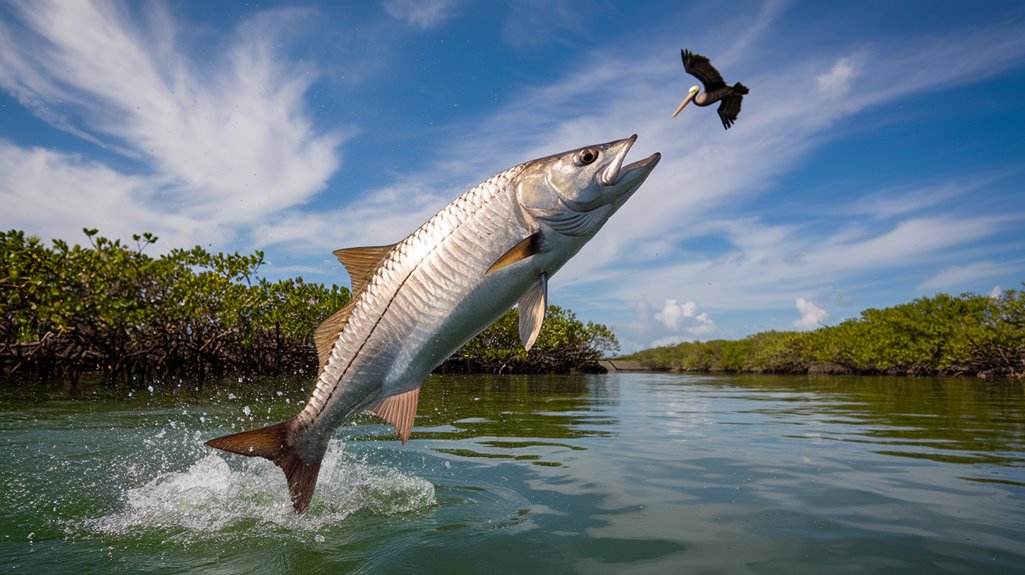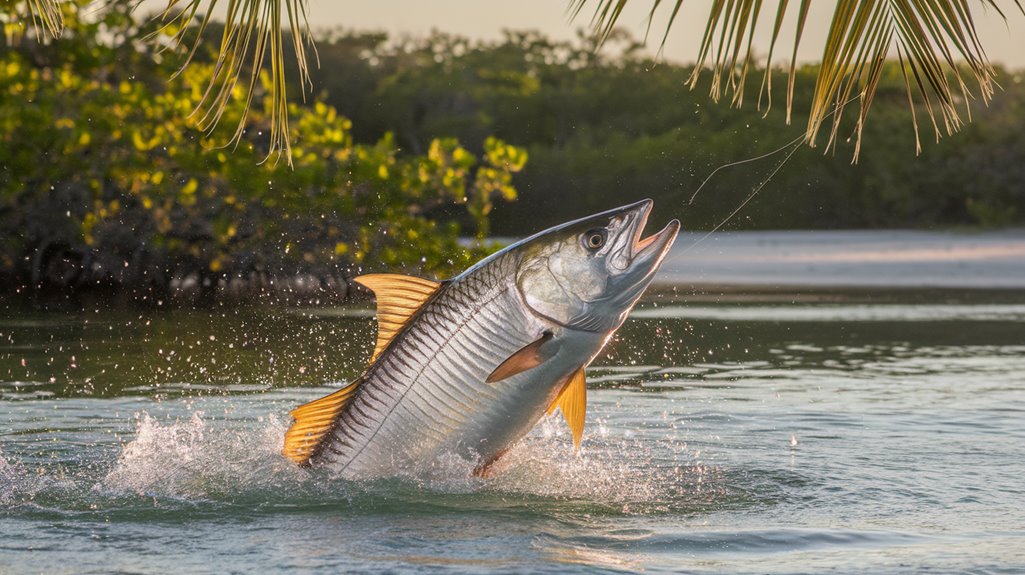You'll find tarpon, the "silver kings" of sportfishing, in some of the world's most enchanting waters. From Cuba's pristine flats to Florida's legendary backcountry, these prehistoric gamefish create bucket-list adventures for anglers worldwide. Whether you're casting to rolling fish in Belize's crystalline waters or battling giants off Gabon's wild coast, each destination offers its own unique challenges and rewards. Let's explore the premier spots where you can test your skills against these magnificent fighters.
- Key Takeaways
- Prime Caribbean Waters: Cuba's Jardines De La Reina and Cayo Santa Maria
- Hidden Gems of Central America: Nicaragua and Costa Rica
- Florida's Legendary Tarpon Grounds
- African Coastal Waters: Gabon's Untamed Frontier
- Mexican Gulf Coast: From Isla Holbox to Tarpon Cay
- Pristine Waters of Belize: River Systems and Flats
- The Florida Keys: Islamorada to Key West
- Everglades National Park: Year-Round Tarpon Haven
- Remote Lodges and Premium Fishing Experiences
- Conservation Areas and Protected Tarpon Habitats
- Frequently Asked Questions
- Conclusion
Key Takeaways
- Florida Keys, particularly Islamorada and Key West, offer world-class tarpon fishing with peak season from April through July.
- Cuba's Jardines De La Reina provides pristine flats fishing for juvenile tarpon, while Cayo Santa Maria targets larger migratory fish.
- Nicaragua and Costa Rica's waters host trophy-sized tarpon exceeding 100 pounds, with peak seasons during spring and late summer.
- Gabon's untouched coastline offers opportunities for giant tarpon over 200 pounds along Africa's longest wild shoreline.
- Belize's 200-mile coastline features year-round tarpon fishing, with peak migration from April to September for trophy-class fish.
Prime Caribbean Waters: Cuba's Jardines De La Reina and Cayo Santa Maria

When it comes to world-class tarpon fishing, Cuba's Jardines De La Reina and Cayo Santa Maria stand out as premier Caribbean destinations. You'll find 100 miles of pristine flats, channels, and mangrove islands in Jardines de la Reina, where aggressive juvenile tarpon under 30 pounds provide non-stop action, with some specimens reaching up to 80 pounds.
At Cayo Santa Maria, a UNESCO biosphere reserve, you can target larger migratory fish from 80 to 160 pounds, especially during the peak season starting in March. The Iberostar Ensenachos resort caters to both anglers and non-fishing companions. Both fishing destinations maintain strict conservation measures to protect their unique ecosystems, ensuring sustainable practices for future generations. You'll experience untouched waters and abundant marine life in these carefully preserved Cuban havens.
Hidden Gems of Central America: Nicaragua and Costa Rica
While Cuba dominates Caribbean tarpon discussions, Central America's lesser-known destinations offer equally impressive opportunities for trophy catches. Nicaragua's Tapam Lodge, limiting access to just four anglers weekly, delivers consistent hook-ups with large tarpon exceeding 100 pounds in its pristine lagoon system. The migratory tarpon season peaks from March onwards, with specimens reaching 150-200 pounds.
Costa Rica's tarpon fishery at Tarponville presents anglers with remarkable opportunities, averaging 90-120 pound fish and potential catches surpassing 200 pounds on the fly. You'll find prime fishing conditions during late summer and fall, post-rainy season, with the possibility of ten hook-ups in a single morning. Both destinations combine world-class fishing with immersive natural environments, offering encounters with diverse wildlife amid stunning tropical landscapes.
Florida's Legendary Tarpon Grounds

Throughout North America's Atlantic seaboard, Florida stands as the undisputed crown jewel of tarpon fishing, particularly during the peak migration from April through July. You'll find world-class opportunities in Islamorada, rightfully dubbed the "Tarpon Capital of the World," where sight-fishing techniques and live bait presentations yield spectacular results.
The Florida Keys chain, especially Key West's island channels, offers prime spots for targeting hundred-pound-class fish during slack water periods. You can explore the Everglades' vast ecosystem, home to a year-round resident population, or test your skills at Miami's Government Cut, a premier winter fishing ground. Whether you're working the flats of Biscayne Bay or stalking migratory giants in the Keys, Florida's legendary tarpon grounds deliver unmatched angling experiences for both novice and seasoned fishermen.
African Coastal Waters: Gabon's Untamed Frontier
Moving beyond North America's tarpon hotspots, Gabon's untamed coastline represents one of sport fishing's last great frontiers. Along Africa's longest wild shoreline, you'll find pristine coastal waters teeming with giant tarpon that can exceed 200 pounds. The country's massive estuary system, enriched with nutrients, creates ideal conditions for trophy game fish.
What sets Gabon apart is its untouched environment, where you'll cast your line against a backdrop of pristine tropical rainforest. Your saltwater fishing adventure here isn't just about the catch – you're sharing the wilderness with forest elephants, buffalo, and gorillas. Whether you're an experienced angler or seeking your first trophy tarpon, these remote waters offer an unparalleled opportunity to test your skills in one of the world's last unspoiled fishing destinations.
Mexican Gulf Coast: From Isla Holbox to Tarpon Cay

You'll find Mexico's Gulf Coast offers exceptional tarpon fishing opportunities throughout the year, with baby tarpon abundant in the mangrove systems and larger migratory specimens appearing during summer months. The strategic positioning of Isla Holbox and Tarpon Cay Lodge puts you directly in the path of both resident and migratory tarpon populations, capitalizing on their natural movement patterns through the region. Whether you're targeting the year-round baby tarpon in San Felipe's turtle grass flats or pursuing trophy fish during peak migration seasons, you'll encounter consistent action across these premier fishing grounds.
Strategic Migration Patterns
Along Mexico's Gulf Coast, tarpon follow distinct migration patterns that make destinations like Isla Holbox and Tarpon Cay prime fishing locations. You'll find juvenile tarpon year-round in the mangrove-lined lagoons, while larger migratory specimens appear during the warmer months along the coast. The strategic positioning of these locations offers you convenient access to both populations.
At Tarpon Cay Lodge in San Felipe, you'll target baby tarpon ranging from 5 to 25 pounds in protected waters. To maximize your success, you'll need to master sight fishing techniques across turtle grass flats and understand local tidal movements. The region's unique geography creates perfect conditions for both resident juvenile populations and the seasonal migration of larger tarpon, giving you diverse fishing opportunities throughout the year.
Year-Round Fishing Opportunities
While many destinations offer seasonal tarpon fishing, Mexico's Gulf Coast provides exceptional year-round opportunities from Isla Holbox to Tarpon Cay. You'll find baby tarpon throughout the seasons in Isla Holbox, with larger migratory specimens appearing during summer months. At Tarpon Cay Lodge in San Felipe, you can target baby tarpon in the 5-25 pound range on the fly, making it an ideal destination for anglers of all skill levels.
The northern Yucatan Peninsula's mangrove lagoons and turtle grass flats offer a less crowded fishing destination where you can practice your technique in a tranquil environment. These diverse ecosystems support consistent year-round fishing opportunities, allowing you to focus on your pursuit without the pressure of peak seasons or competing with other anglers.
Pristine Waters of Belize: River Systems and Flats
You'll find Belize's 200-mile coastline offers an impressive network of river systems, including the Belize and Sibun Rivers, where resident juvenile tarpon in the 5-20 pound range thrive year-round. During the peak migration from April to September, you can target trophy-class tarpon weighing 30-100 pounds as they move through coastal flats and shoals. Your opportunities expand across diverse fishing environments, from remote island flats to accessible river mouths, where the pristine waters and rich biodiversity create ideal conditions for both resident and migratory tarpon.
River Habitat Diversity
Extending over 200 miles of pristine coastline, Belize's diverse river systems create an ideal habitat for both resident and migratory tarpon populations. The coastal rivers, including the Belize and Sibun, offer year-round opportunities to target these powerful gamefish. You'll find juvenile tarpon weighing 5-20 pounds in the river habitat diversity, while larger specimens of 30-100 pounds frequent these waters during their migration from April to September.
- Mangrove estuaries serve as protected nursery grounds for juvenile tarpon
- Nutrient-rich habitat created by freshwater and saltwater mixing attracts abundant forage fish
- Shallow flats provide prime sight-fishing opportunities for resident tarpon
- Multiple river systems offer varied fishing experiences throughout the seasons
The interplay between these ecosystems guarantees a thriving tarpon fishery that's both challenging and rewarding.
Seasonal Migration Patterns
Throughout Belize's pristine coastal waters, tarpon exhibit distinct migration patterns that create exceptional angling opportunities. The peak migration occurs from April through September, when you'll find these powerful gamefish congregating in flats and shoals along the 200-mile coastline.
You'll encounter both resident and migratory tarpon in Belize's shallow water ecosystems, with specimens typically ranging from 30 to 100 pounds. The nutrient-rich estuaries and coastal rivers, including the Belize and Sibun, support year-round populations while serving as essential nursery grounds for juveniles. During seasonal migrations, these areas become even more productive for anglers targeting tarpon. Whether you're fly fishing or using conventional tackle, you'll find consistent hook-up rates as these magnificent fish move through Belize's diverse marine habitats.
Coastal Flats Fishing Hotspots
Belize's pristine coastal flats offer some of the Caribbean's most productive tarpon fishing grounds. Along 200 miles of coastline, you'll find resident tarpon populations year-round, with fish ranging from 30 to 100 pounds. The Belize River and Sibun River systems become especially active during the April-to-September migration, when you can target both resident and migratory fish.
- Ambergris Caye provides premier sight fishing opportunities for 40-60 pound tarpon
- Coastal rivers and flats create ideal habitats for consistent year-round action
- Strategic fishing lodge locations offer direct access to prime fishing grounds
- Diverse habitat combinations of flats and shoals maximize your chances during migration
You'll find tailored experiences through local lodges that cater specifically to targeting these silver kings, whether you're using fly tackle or conventional gear.
The Florida Keys: Islamorada to Key West
The Florida Keys, from Islamorada to Key West, stand as America's premier tarpon fishing destination, with Islamorada rightfully claiming its title as the "Tarpon Capital of the World." During the peak season from April to July, massive schools of migrating tarpon create unparalleled fishing opportunities in the region's diverse waterways.
You'll find silver kings ranging from 50 to 100 pounds in channels, flats, and around bridges throughout the Keys. Key West's channels between islands offer excellent opportunities during slack water, especially on calm, sunny days when large females are present. For year-round action, you can head to Everglades National Park, where river mouths and beaches consistently produce aggressive tarpon. Whether you prefer conventional tackle or tarpon fly fishing, the Florida Keys deliver world-class experiences for anglers of all skill levels.
Everglades National Park: Year-Round Tarpon Haven
You'll find Everglades National Park offers exceptional year-round tarpon fishing opportunities, with the action peaking during the April-to-July migration season. Your essential tackle should include heavy spinning gear or fly equipment capable of handling 80-150 pound fish, along with a variety of large plugs and live bait options such as mullet or ladyfish. For the most productive fishing spots, target the river mouths and beaches along Cape Sable, where tarpon regularly gather to feed in the park's nutrient-rich waters.
Peak Fishing Seasons
Countless anglers flock to Everglades National Park for its exceptional year-round tarpon fishing opportunities, thanks to a robust resident population that's complemented by seasonal migrations. You'll find peak migration from April to July, when the waters come alive with increased tarpon activity. During these months, you can target these powerful gamefish in diverse locations throughout the park's ecosystem.
- Choose between Whitewater Bay and Ponce de Leon Bay for early-season arrivals
- Fish river mouths and beaches where tarpon congregate during peak migration
- Deploy large plugs or live bait like mullet and ladyfish for ideal results
- Prepare for hard fights and proper catch-and-release techniques to protect the species
The combination of resident and migratory populations guarantees you'll have consistent opportunities to land these prized fighters throughout the calendar year.
Essential Tackle Requirements
Successfully landing tarpon in Everglades National Park demands specific gear matched to these powerful gamefish. You'll need specialized tackle to handle both the resident population and larger specimens during peak fishing times. For targeting these acrobatic runs effectively, equip yourself with heavy spinning gear or 12-weight fly fishing setups.
| Tackle Type | Size Range | Best Application |
|---|---|---|
| Spinning Rod | 30-50 lb | Deep Channels |
| Fly Rod | 11-12 wt | Flats/Beaches |
| Backing Line | 200-300 yds | All Locations |
| Leaders | 60-80 lb | Live Bait/Flies |
Your reel must hold sufficient backing to withstand extended runs, while your main line should test between 30-50 pounds. When fly fishing, verify your leader system can turn over larger flies while maintaining enough strength to control these powerful gamefish during the fight.
Best Fishing Spots Revealed
When seeking the ultimate tarpon fishing destination, Everglades National Park stands out as a premier year-round haven for these coveted gamefish. You'll find large resident fish throughout its diverse fishing waters, with peak opportunities during the April-to-July migration. The park's unique blend of saltwater and freshwater environments creates ideal conditions for consistent tarpon action.
- Cape Sable's beaches and river mouths offer prime casting spots for large plugs and live bait
- Extensive mangrove systems provide protected waters for saltwater fly fishing
- Estuarine areas support a healthy population of resident tarpon year-round
- Multiple access points let you target fish in both shallow and deep waters
Anglers looking for reliable tarpon fishing will discover that the Everglades' exceptional ecosystem delivers outstanding opportunities in every season, whether you're sight-casting in the backcountry or working the coastal waters.
Remote Lodges and Premium Fishing Experiences
For anglers seeking the ultimate tarpon fishing experience, premium lodges offer exclusive access to world-class waters while delivering exceptional service and comfort. You'll find Tapam Lodge's intimate fishing operation in Nicaragua limiting weekly guests to just four, ensuring personalized pursuits of silver tarpon exceeding 100 pounds.
Costa Rica's Best Destinations include Tarponville, where you're likely to encounter multiple hookups with 90-120 pound specimens in a single session. At Sette Cama's fly fishing lodge in Gabon, you'll target aggressive giant tarpon up to 200 pounds against pristine rainforest backdrops. Casa Blanca Lodge in Mexico provides strategic positioning between two productive bays, while Bahia Honda Sporting Club delivers a refined Florida Keys experience with private beach access and upscale amenities.
Conservation Areas and Protected Tarpon Habitats
Throughout the world's premier tarpon fishing destinations, protected conservation areas serve as significant sanctuaries for these magnificent gamefish. Marine reserves in Belize, Cuba's Jardines de la Reina, and Mexico's Sian Kaan Biosphere Reserve showcase how conservation areas protect essential tarpon habitats. These protected zones maintain sustainable fishing practices while preserving critical migratory routes and spawning grounds.
- Mangrove estuaries and shallow coastal waters provide significant nursery grounds for juvenile tarpon
- Protected areas enforce responsible fishing guidelines to prevent overfishing
- Conservation initiatives in Costa Rica and Gabon focus on habitat preservation and population management
- Marine reserves help maintain ecosystem balance, ensuring long-term tarpon survival
The integration of these protected zones creates a network of safe havens where tarpon can thrive, supporting both species conservation and world-class angling opportunities.
Frequently Asked Questions
Where Is the Best Place to Catch Tarpon in the World?
You'll find exceptional tarpon fishing at Tarponville, Costa Rica, where you can hook 90-120 lb fish regularly, land 200+ pounders on fly, and experience up to ten strikes each morning.
Where Is the Best Place to Catch Tarpon?
You'll find exceptional tarpon fishing at Tarponville, Costa Rica, where you can hook multiple 90-120 lb fish in a morning, with real chances at landing 200+ pounders on the fly.
Where Is the Best Place to Fly Fish for Tarpon?
You'll find exceptional fly fishing for tarpon at Tarponville, Costa Rica, where you can expect 90-120 lb fish and multiple hook-ups daily, with some monsters exceeding 200 lbs on the fly.
Where Do You Catch Tarpon?
You'll find prime tarpon in Florida Keys, Cuba's Cayo Santa Maria, Belize's coastal rivers, Costa Rica's lagoons, and Gabon's estuaries. Each location offers unique seasonal opportunities and size variations.
Conclusion
You'll find world-class tarpon fishing across these diverse destinations, each offering distinct advantages for targeting these magnificent gamefish. Whether you're sight-casting in Cuba's pristine flats, battling monsters off Gabon's coast, or working the bridges in the Florida Keys, you're participating in a technical pursuit that demands skill and patience. Choose your location based on seasonality, preferred fishing methods, and target size specifications.

